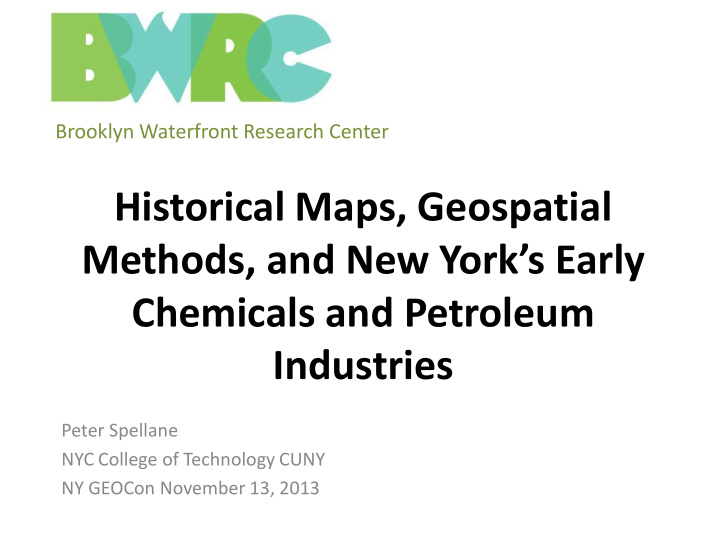



Brooklyn Waterfront Research Center Historical Maps, Geospatial Methods, and New York’s Early Chemicals and Petroleum Industries Peter Spellane NYC College of Technology CUNY NY GEOCon November 13, 2013
Old maps
New maps
The point of this talk : 1 History In the 19 th and 20 th centuries … 2 Economic geography Newtown Creek, a narrow channel between Brooklyn and Queens … 3 Geospatial referencing Examined with GIS methods, historical maps … 4 Environmental legacy
Photograph, Robin Michals
Abraham Gesner’s process for refining kerosene from coal: After the liquid was obtained by dry distillation in a closed retort, it needed to be chemically treated to removed undesirable impurities. Gesner used sulfuric acid, 5 to 10 percent the volume of the oil being treated. US Patent 11203 (1854)
1859: illuminating oils By the fall of 1859, there were in this country at least 33 "coal- oil" refineries actively engaged in the manufacture of hydrocarbon illuminating oils that differed very little in chemical composition from the petroleum-based illuminants that would shortly displace them. By far the largest of these coal-oil works was the pioneer plant of the New York Kerosene Oil Works, located on the east bank of Newtown Creek in what is now the Borough of Queens. From “Dr. Gesner's Kerosene: The Start of American Oil Refining,” by Kendall Beaton, The Business History Review, Vol. 29, No. 1 (Mar., 1955), pp. 28-53 .
Charles Pratt “Pratt was especially interested in the emerging petroleum industry and in the 1860s he helped oversee the creation of the Devoe and Pratt Manufacturing Company — later the Devoe Manufacturing Company. This subsidiary operated an oil refinery on the Newtown Creek in Queens. Its special “Patent Cans” were particularly well suited to exporting kerosene lamp oil and other products to warm climates such as the Far East, and its brand was recognized throughout the world.” Landmarks Preservation Commission, October 28, 2008, Designation List 406, LP-2308, F.W. DEVOE & CO. FACTORY
Flow chart of batch operations at Pratt Oil Refinery ca. 1871, producing kerosene from petroleum from F. Williamson and A. R. Daum, The American Petroleum Industry, Evanston, Northwestern University Press, 1959
Gasoline still, fractionating tower, and condenser at the Pratt Astral Oil Works. (Scientific American, Supplement, May 18, 1872)
Newtown Creek, East of the Greenpoint Avenue Bridge, including detail of the Charles Pratt Oil Works in Queens. From Higginson’s Insurance Maps of the city of Brooklyn L.I. surveyed, drawn & published by J.H. Higginson. 1868. Volume 4, detail from plate 85. Courtesy of New York Public Library.
Pratt’s Astral Oil
Sulfuric acid production and oil refineries
William Nichols and Newtown Creek William Nichols, born in Brooklyn in 1852; attended Brooklyn Polytechnic Institute and New York University, earning a BS degree in Chemistry in 1870. 1870 Nichols joined Laurel Hill Chemical Company as a chemist. In 1871, with Baumgarten retired, the company became Walter and Nichols Co. The company acquired more land and built capacity for production of sulfuric acid, HNO 3 , and HCl. Reorganized as G. H. Nichols and Company. 1876 J. B. F. Herreshoff joined the company, began a career of developing new technologies that affected all areas of the company’s operations. 1880s As other producers did, the G. H. Nichols Co. began to use pyrites as the source for sulfur (formed in the thermal decomposition of FeS 2 ). 1890 G. H. Nichols develops an interest in refining copper from the company’s pyrite waste stream. 1890 Herreshoff developed a form of the contact catalytic process (SO 2 product of chamber process oxidized to SO 3 in flow though red-hot Pt tube), with strong effects on the company’s fortunes. 1891 G. H. Nichols and Co. splits, conveying land to the Nichols Chemical Company; G. H. Nichols and Co continues to refine copper. 1892 Nichols constructs one of the first large-scale systems for electrolytic refining of copper: Nichols Lake Substitute (NLS) competes with Lake Superior copper, the US Bureau of Mines standard. 1895 Nichols produces high purity blister copper, cast as bars, ingots, wire, etc. G. H. Nichols and Phelps Dodge (supplier of pyrite) form partnership. 1899 Nichols leveraged the company’s catalytic contact process to organize the General Chemical Company, merging 12 companies an d 19 plants. By the time Germany invaded Belgium, August 1914, the US sulfuric acid industry produced 4,047,982 short tons annually. The combined total of Britain, Germany, and France was about half as great. REF: C.Cravens, Copper on the Creek, Furnace Press, New York, 2000; W., American Chemical Industry, background and Beginnings, Garland Publishing, Inc., New York and London, 1983; H. Wigglesworth, Industrial and Engineering Chemistry 19, 1205-6 (1927).
John D. Rockefeller; the growth of the Standard Oil Company at Newtown Creek
NYC DOITT aerial photograph 1924
NYC DOITT aerial photograph 2010
Photograph, Robin Michals
Thank you. Brooklyn Waterfront Research Center Anne Leonard Robin Michals New York Public Library: The Lionel Pincus and Princess Firyal Map Division and the Science Industry and Business Library Brooklyn Historical Society
This work has been made possible in part by two major grants from the National Endowment for the Humanities. Because democracy demands wisdom. Water and Work: The Ecology of Downtown Brooklyn A one-year seminar series for sixteen faculty members, along with a public symposium, on the natural and cultural history of Brooklyn's waterfront. Along the Shore: Changing and Preserving the Landmarks of Brooklyn's Industrial Waterfront Two one-week workshops for fifty community college faculty members on selected Brooklyn waterfront landmarks.
Recommend
More recommend